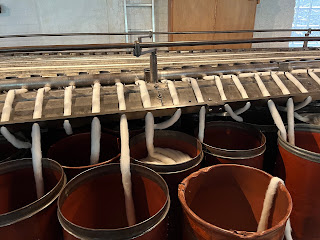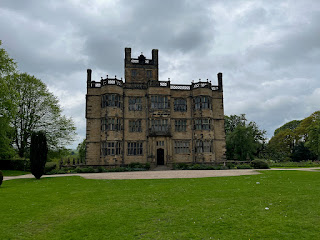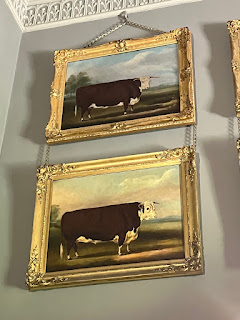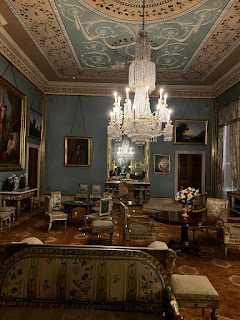We were quite surprised to awake to bright blue skies this morning, and more than happy to take them! We drove off to Attingham Park, which is another National Trust Site, (we're making use of our membership.)
The stable yard features a clever presentation regarding the life of bees and the importance of protecting them.
In fact, the grounds hold a Georgian Bee House, built in the early 1800's.
First time I've seen something like that!
The gardens weren't huge, but certainly beautiful to behold on this brilliant day!
They are nestled in a walled garden.
We opted to take the mile walk around the stream that runs through the property. Rhododendrons were in bloom, scattered in different colors, here and there.
The walk was quite picturesque, offering some sort of delight along the way.
It ended towards the back of the house, so we headed around front to the grand entrance.
Attingham is an English country house built in 1785. Over the years, it underwent various improvements, dependent upon the owner at the time.
Once through the door, the Trust Volunteer gave us detailed directions regarding our movements through the house which actually became quite amusing as she continued to point on a schematic with her finger, showing the path to take from room to room. I was just hoping there wasn't a test at the end, because it sure was a lot of information to try to remember!
And I actually had to laugh out loud when she announced that she calls the room in which we were standing, the "fake" room, because most of its decor was just that. Marble columns that were neither marble or a support column, but made to look such. Frescoes on the walls that were really just paintings, and wallpaper that was actually paint.
But the overall effect was certainly convincing at first glance.
I did spy some interesting chairs in the room, though, which dated back to the 1700s. Those were real.
Walking into the next room, we found ourselves enhanced in the aura of dining here in the evening. The room was dark, lit only by candlelight (electric, of course). What a unique way to expose the modern visitor to the experience of dining in the 1700's.
A couple of paintings caught my eye. I just loved this one, although the photo lost something in the color.
And around the corner, in the library, there was this outdoor setting of Thomas Hill and his family. It is dated 1730.
I never cease to be amazed at the age of these painting, and the excellent condition that they maintain.
On a lighter note...there were "cattle" paintings
lots of cattle paintings
all hanging in one room
and obviously special in some regard, although just what isn't mentioned anywhere.
I'll be honest....I've never seen a cow that looks like that, with a bulge in the chest. But there were obviously many who were held in high regard if they made the wall for all to see.
Down the hall, there is a drawing room, beautifully decorated in blue.
and a smaller room, resembling a Wedgewood like look.
We entered a very long room, filled with countless paintings hanging on the walls, all of which had been collected over the years by family members. And, just off this room was a grand staircase that led upstairs to the bedrooms.
The rooms were not open for viewing, so we went back down the stairs for a quick look at the boudoir, which was quite small, but had some beautiful decor.
Heading downstairs, there were the familiar servant's bells.
And it was at this point that we were introduced to the expectations of the servants. There were plates set on a long table, complete with place settings, that described who sat where, and what role that servant played in the household.
What a brilliant idea! And the Rules of conduct were hung on the wall to assure consistency.
It seemed to me that there were some vital household helpers who were missing. Going down the hall, I soon learned that in larger households, the "more important" staff ate their meals separate from the others.
Something I had never learned watching Downton Abbey!
The kitchen was bright and spacious, although I don't know if I would have enjoyed a pie decorated with the part of the pheasant that wasn't used.
It was obvious that the family who occupied the house held a high status among peers, and had hired staff to be able to produce meals to impress.
Once again, I was impressed with the detail presented in regards to the servants. All too often we read about the owners of these large houses, but rarely about those people who were instrumental to the house running smoothly.
From here, we headed to Benthall which is a much smaller house owned by the National Trust. But I do have to say, both places were super busy, and the parking lots were brimming with cars from visitors. Many were locals, as they came with dogs in tow to walk the wooded paths that weave along the estates.
Benthall was a fascinating house to visit. The family were originally sheep farmers, living on this land before 1066. In the 1200's, it was discovered that the land held a great amount of surface coal. That discovery led to prosperity, which led to advantageous marriages, which resulted in even more prosperity.
Benthall original home was constructed in 1535 with the final phase completed in 1583.
The Wisteria vines on the front, were in full bloom, adding to the beauty of the exterior.
Inside, only a few items of the original house remain. One is this coat of arms that hangs upon the mantle in the dining room. It dates back to the early 1600s.
The library also holds panelling and some ornate wood work from the origins.
and beneath the wooden floor in the dining area, it was discovered that there were decorative tile floors beneath the wood.
In the early 1900's, the house was rented to the Moore brothers, (famous tile makers) who went about "renovating" it. This photo shows exactly what the pattern under the wooden floors would look like.
There were not many rooms inside, and they were actually rather simply decorated in comparison to the other places we have visited recently.
There was a small outside garden along the side of the house.
A church stands on the grounds, and it is still used for services on occasion.
It didn't take much time to go through the house and garden, so we decided to head to Ironbridge to see just what was there. It was on our way back, so why not check it out?
The view was pretty spectacular as we made our way down the hill.
The houses perched on the hillside were pretty impressive.
and here you see it, yet another UNESCO World Heritage site. The world's first iron bridge, completed in 1780.
It's only accessible by foot, so we walked out half way, then back again. The place was buzzing with people, out enjoying this spring day.
We headed back to our room and relaxed a bit before walking to Mass at a nearby church, then enjoying a lovely dinner in the hotel restaurant. Such convenience is a luxury!
We head out tomorrow, making our way to the Yorkshire Dales. If the weather continues to be this beautiful, we should be in for a real treat!
I'll be sure to keep you posted!

































































































